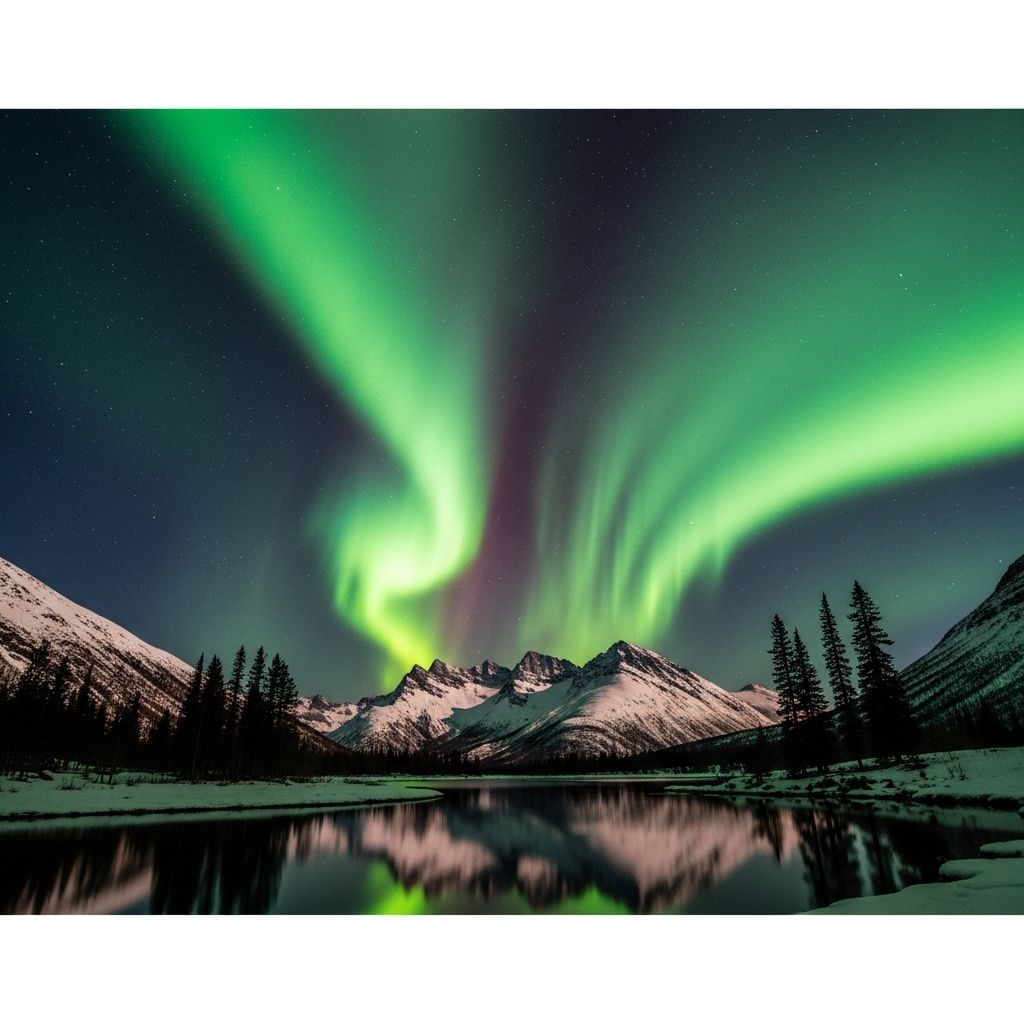Northern Lights: Expert Guide To Aurora Science & Viewing
Discover the dazzling phenomenon of auroras: their origins, colors, cultural significance, and how to witness their breathtaking displays.

Image: HearthJunction Design Team
Northern Lights: The Science and Spectacle of Earth’s Auroras
The northern lights, or aurora borealis, have enchanted and mystified skywatchers for millennia. These dancing ribbons of light illuminate polar skies with brilliant greens, reds, purples, and even rare blues. Yet beneath their beauty lies a violent, cosmic interaction—a tale of solar storms, Earth’s magnetic shield, and the delicate dance of atoms high above our planet. This article explores the science, spectacle, history, and personal experience of auroras, offering a comprehensive look at one of nature’s most captivating wonders.
What Are the Northern Lights?
The northern lights, or aurora borealis, are luminous displays that shimmer and twist across the night sky near the poles. They are matched in the Southern Hemisphere by the aurora australis—the southern lights. Both phenomena belong to the broader class of auroras, atmospheric light shows caused by energetic interactions between charged particles from the sun and Earth’s upper atmosphere .
- Aurora borealis: Northern lights, visible in skies above the Arctic Circle.
- Aurora australis: Southern lights, observable near the Antarctic Circle.
In Latin, “aurora” means “dawn,” and “borealis” refers to the north. Together, the name evokes the radiant glow that has inspired legends, scientific inquiry, and awe throughout human history .
How Do Auroras Form?
At the heart of every aurora is the sun—and a series of high-energy cosmic events that unfold millions of kilometers from Earth. Here’s how this celestial spectacle comes to life:
- Solar wind: The sun constantly emits a stream of energized, electrically charged particles—mostly electrons and protons—known as the solar wind. These particles travel across space at high speeds, driven by solar activity like flares and coronal mass ejections .
- Earth’s magnetosphere: As the solar wind approaches Earth, our planet’s magnetic field acts as a protective shield, diverting most particles away. However, near the magnetic poles, the field lines dip down and allow some particles to enter the upper atmosphere.
- Atmospheric collisions: Charged solar particles collide with atoms and molecules in Earth’s upper atmosphere—primarily oxygen and nitrogen. These collisions transfer energy, causing the atmospheric particles to become “excited.”
- Light emission: As the excited atoms and molecules relax back to their normal state, they release energy in the form of light. This glow is what we see as auroras .
Key Facts About Aurora Formation
- Solar particles can reach speeds up to 45 million mph (72 million kph) before striking Earth’s atmosphere .
- The magnetosphere channels these particles toward the polar regions, creating the characteristic auroral ovals around the magnetic poles .
- The altitude at which auroras occur ranges from 60 miles (100 km) to over 400 miles (640 km) above the surface.
The Color Palette of Auroras
The most breathtaking aspect of auroras is their swirling tapestry of colors. Each hue arises from the type of atom or molecule involved in the collision, as well as the altitude at which the interaction occurs .
| Color | Atmospheric Source | Altitude Range | Frequency |
|---|---|---|---|
| Green | Oxygen | ~60-150 miles (100-240 km) | Most common |
| Red | Oxygen, Nitrogen | Above 150 miles (240 km) | Less common |
| Purple & Violet | Nitrogen | 60-250 miles (100-400 km) | Rare |
| Blue | Nitrogen | Below 60 miles (100 km) | Very rare |
| Pink | Oxygen & Nitrogen mix | Varies | Rare |
Every atom and molecule has a unique “fingerprint” of light it can emit. This is why aurora colors are so varied and why no two auroral displays are ever quite the same. Green is the most often observed color, resulting from oxygen molecules about 60 miles above the ground. Red tones are produced by high-altitude oxygen and nitrogen, while purples and blues are linked to nitrogen molecules .
Where and When Can You See the Northern Lights?
Auroras are most frequently visible in the auroral ovals, which are doughnut-shaped regions centered around the magnetic poles . The following factors affect your chances of witnessing this phenomenon:
- Latitude: The closer you are to the magnetic poles, the better your chances. High-latitude countries like Norway, Sweden, Finland, Canada, Iceland, Greenland, and Alaska are prime locations.
- Solar activity: Strong solar storms—caused by increased sunspot activity—can push auroras to lower latitudes. Occasionally, auroras are visible as far south as northern U.S. states or central Europe .
- Seasons: Winter and early spring offer longer nights and clearer skies, increasing the opportunity for a good viewing session.
- Weather: Clear, dark skies free from light pollution are essential for optimal viewing.
Top Destinations to See the Northern Lights
- Norway (Tromsø, Svalbard)
- Sweden (Abisko)
- Finland (Lapland)
- Iceland (Reykjavík, Thingvellir National Park)
- Canada (Yukon, Nunavut, Northwest Territories)
- Alaska (Fairbanks, Denali)
- Scotland (occasionally during major storms)
Cultural Significance and Legends
Auroras have long fascinated, mystified, and sometimes frightened people across the world. They appear in ancient mythology, folk tales, and even contemporary cultural identities:
- Iñupiat (Alaska): The northernmost peoples call the aurora kiuġuyat or kiuġiyaq, and have traditions explaining its presence and power .
- Scandinavia: In Norse legend, auroras were thought to be reflections from the shields of Valkyries or the glow from the Bifrost bridge connecting the mortal world to Asgard.
- Indigenous North Americans: Some Native Canadian tribes believed the lights to be torches of spirits guiding souls to the afterlife.
- Europe: Medieval Europeans sometimes saw the lights as omens of war or impending calamity.
Today, auroras continue to inspire art, poetry, photography, and scientific curiosity worldwide.
Scientific Discoveries: The Physics Behind Auroras
- Magnetosphere: Earth’s magnetic field protects us from harmful solar radiation, funneling energetic particles into the polar regions.
- Energy transfer: When solar wind particles collide with atmospheric atoms, they excite electrons to higher energy levels. The subsequent return to ground state emits photons—visible light.
- Solar storms: Powerful solar eruptions increase the intensity and reach of auroras, sometimes pushing them to latitudes much lower than usual .
Auroras on Other Planets
Auroras are not unique to Earth. They occur on any planet or moon with an atmosphere and a magnetic field:
- Jupiter: Strong magnetic fields produce massive, powerful auroras—sometimes observed by the Hubble Space Telescope .
- Saturn: Also produces stunning auroral displays in its polar regions.
- Mars, Uranus, Neptune: Evidence of auroral-like phenomena, though often less vivid due to thinner atmospheres and magnetic fields.
This cosmic ballet illustrates the universal principles of magnetism, plasma, and electromagnetic energy that permeate our solar system.
Watching the Northern Lights: Tips for the Best Experience
- Timing: Check solar activity forecasts; periods of high solar wind or solar storms improve your odds.
- Location: Seek dark, clear skies away from city lights, ideally above the Arctic Circle.
- Equipment: While auroras are visible to the naked eye, a camera with manual settings and a tripod can capture even more colors and detail.
- Patience: Auroras are unpredictable. Be prepared to spend several nights watching the skies.
Frequently Asked Questions (FAQ)
Q: What causes the different colors seen in the northern lights?
A: The color depends on the type of gas molecules in Earth’s atmosphere and the energy of the incoming solar particles. Oxygen produces green and red lights, while nitrogen yields blue and purple hues .
Q: Can the northern lights be predicted?
A: Yes, to some extent. Scientists monitor solar activity and can forecast geomagnetic storms that lead to auroras. However, exact timing and location are always subject to the unpredictability of space weather .
Q: Why are auroras mostly visible near the poles?
A: Because Earth’s magnetic field channels charged solar particles toward the north and south magnetic poles, creating concentrated regions of auroral activity known as auroral ovals .
Q: Are auroras dangerous?
A: Auroras themselves are harmless light shows. However, the geomagnetic storms that power them can interfere with satellites, electrical grids, and navigation systems.
Q: Do other planets have auroras?
A: Yes! Auroras have been observed on Jupiter, Saturn, and even Mars, as long as there is an atmosphere and a magnetic field to interact with solar winds .
The Lasting Allure of Auroras
From ancient myths to high-tech discoveries, the northern lights remain one of Earth’s most mesmerizing phenomena. Whether observed from a remote Arctic outpost or captured in stunning images from space, they remind us of the profound forces shaping our world—and our enduring human impulse to watch, wonder, and explore.
References
- https://www.space.com/15139-northern-lights-auroras-earth-facts-sdcmp.html
- https://spaceplace.nasa.gov/aurora/en/
- https://www.hurtigruten.com/en-us/inspiration/northern-lights/science
- https://www.rmg.co.uk/stories/space-astronomy/what-causes-northern-lights-aurora-borealis-explained
- https://science.nasa.gov/sun/auroras/
Read full bio of medha deb











